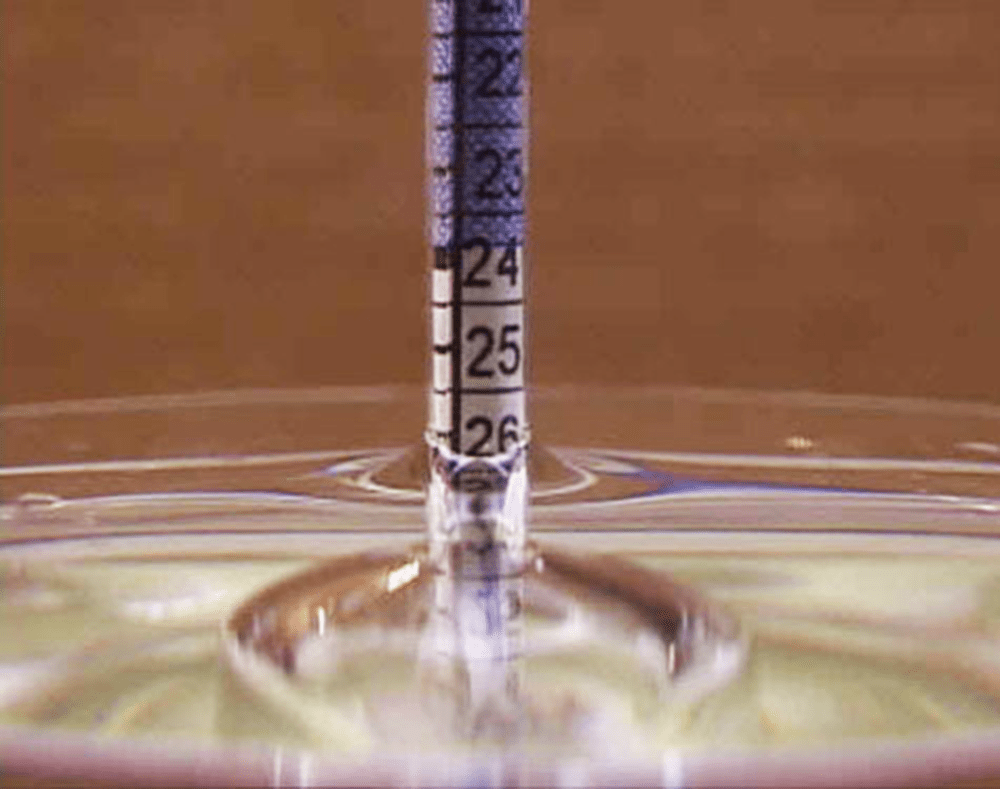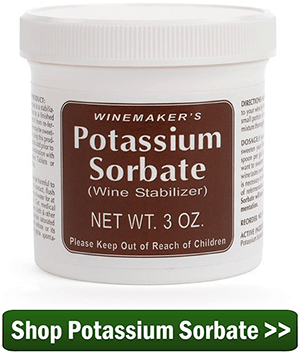 Ok I need a wine making for dummies book! I am attempting to make my first batch of wine. I followed my recipe as directed. I just racked it for the first time. I checked my alcohol content and it is zero!! And it is bitter, as if I did not even put sugar. It is a 2 gallon batch. What can I do to fix this???
Ok I need a wine making for dummies book! I am attempting to make my first batch of wine. I followed my recipe as directed. I just racked it for the first time. I checked my alcohol content and it is zero!! And it is bitter, as if I did not even put sugar. It is a 2 gallon batch. What can I do to fix this???
Name: Kathaleen W.
State: LA
—–
Hello Kathaleen,
Everything you stated above indicates that your wine is doing fine. The zero reading you got — with what I am assuming was a wine hydrometer — does not mean your wine has zero alcohol. It means that there is no more alcohol that can be made from the sugar you added. Let me explain.
A fermentation is all about turning sugar into alcohol. The wine yeast consumes the sugar and metabolizes it into alcohol, along with CO2 gas. As the wine ferments, the sugar level goes down and the alcohol level goes up. If a fermentation is completely successful, the sugars will be completely gone.
Your hydrometer is not reading how much alcohol is in your wine. It is reading how much more alcohol can be made with the sugars that are currently in the wine. That is why the scale you are reading is  called “potential” alcohol. It is telling you that the fermentation has the potential to make 0% more alcohol with the sugar that is currently in the wine — which is none.
called “potential” alcohol. It is telling you that the fermentation has the potential to make 0% more alcohol with the sugar that is currently in the wine — which is none.
You already stated that your wine taste bitter, “as if I did not put in sugar“. This makes perfect sense and matches up to the fact that you have a potential alcohol reading of zero — zero potential, zero sugar.
To know how much alcohol is in the wine, now, you have to have a potential alcohol reading from the beginning of fermentation — on that was taken at the same time you mixed all the ingredients together and added the wine yeast. As an example, if you had a beginning potential alcohol reading of 12% and you now have a potential alcohol reading of 0%, that tells us that your wine has a alcohol level of 12%. It’s the beginning reading minus the current reading.
Obviously, you are not happy with your wine, and I understand, completely. I doubt if I would like it either, based on what your described. You do not want your wine bitter and bone-dry. You’ll be happy to know that both of these characteristics are completely normal, and expected, at this point in the wine making process.
The main reason your wine is bitter is because it has not yet had time to clear and age. The wine will change remarkably between now and the time you bottle your wine. And the best part is you don’t have to do a thing except wait and be patient. What you are tasting now is mostly wine yeast, and  proteins from the fruit such as tannin. All of these things will make the wine taste bitter. Once they have had time to drop out you will notice an unbelievable improvement.
proteins from the fruit such as tannin. All of these things will make the wine taste bitter. Once they have had time to drop out you will notice an unbelievable improvement.
If you do not want your wine to be dry but sweet, that’s okay, but now’s not the time to be concerned with this either. You will want to back-sweeten the wine just before bottling it. Just sweeten it with a sugar syrup to taste and then add a wine stabilizer at the same time to keep it from fermenting the new sugars while in the wine bottle. That would be a bad thing.
Happy Wine Making,
Ed Kraus
—–
Ed Kraus is a 3rd generation home brewer/winemaker and has been an owner of E. C. Kraus since 1999. He has been helping individuals make better wine and beer for over 25 years.

For determining the final ABV, don’t forget the fermcalc method. If one didn’t record a beginning SG reading, this method will give a very reasonable estimate of alcohol content.
Bill, what is the fermcalc method?
we put in our own blueberry wine recipe on January 2014,it is now july 2014 and the wine is still fermenting.we have racked it once.there is still foam on the top of the wine and it is very sweet.what can we do to get rid of the sweetness.?
Mabel, having a successful, continued fermentation is what is going to get rid of the sweetness. The yeast consumes the sugar and turns it into alcohol and CO2 gas. Please take a look at the Top 10 Reasons For Fermentation Failure to see if any of these reasons strikes a cord with what you did.
Top 10 Reasons For Fermentation Failure
http://www.eckraus.com/wine-making-failure/
This is what Bill said “For determining the final ABV, don’t forget the fermcalc method. If one didn’t record a beginning SG reading, this method will give a very reasonable estimate of alcohol content”.
Does anyone know what the fermcalc method
I too failed to get a 1st sg on my batch of mead. Talking to a chemist friend, he suggested getting a proof and trialled hydrometer. Reading various articles, it is not recommended. If as in spirits, using one will give an ABV, why not mead or wine. Thanks from a new meadstro.
Meadstro, the alcohol hydrometer proof and tralles scale is not accurate in wine or beer. The reason it does not work is the density of the liquid. Beer and wine have too much body and it throws the reading off. Distilled spirits with higher alcohol is a thinner liquid.
Thanks for interesting and clarifying answer regarding reading the wine hydrometer. I was however taught following method, starting SG minus ending SG, result multiplied by 1.29 equals final alcohol %. Correct or not?
Also concerning wine stabilizer, is it added before back sweetening or with the sugar syrup? Thank you.
,
Yes, that is correct. It does the same thing the potential alcohol scale does.
So, I measured the SG of my friends wine at racking time. I have two hydrometers both reading SG less than 1,
potential alcohol less than zero. Instead of a closed cork , we reinsert an air lock. The wine bubbles actively for many days later. What is going on? I cannot convince anyone that fermentation is not going on. Any ides what is?
Temperature, barometric, variations ,universal gas law fluctuations. They deny my science.
Thanx!
There are several things that could be causing this.
A slight fermentation still continuing–It’s not likely to be this. Base on the SG reading the most you would get is maybe a handful of bubbles a day.
Change in barometric pressure–Not likely to be this either. Unless you’re in the eye of a hurricane, the amount of bubbles cause by this is even less than the fermentation continuing would cause.
Temperature Change–If the wine is in a carboy shaped container, when the wine warms up it will expand causing air in the head-space to bubble out. Again, minimal bubbling.
CO2 Gas Escaping–This is what it most likely is, or this in combination with some of the other above reasons. During the fermentation CO2 is produces. Not only does is escape through the airlock, it will also saturate into the wine. Whatever the wine can’t hold the rest bubbles off. This is no different than the carbonation is soda pops. How much CO2 the wine can hold is dependent on the wines temperature. The warmer the wine the less it can hold. So if the wine’s temperature changes, say it goes up by 2 or 3 degrees, a significant amount of CO2 can be released.
Thanks!!